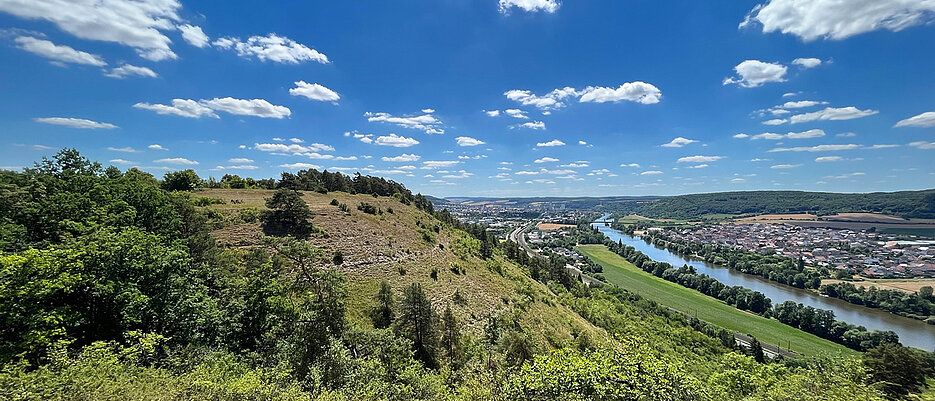What measures are suitable for providing better living conditions for insects in typical Franconian landscapes? This question was investigated by a research team from the University of Würzburg. The results are now available.

Biodiversity is under threat worldwide. While the Intergovernmental Science-Policy Platform on Biodiversity and Ecosystem Services (IPBES) estimated in 2019 that one million out of eight million species are threatened with extinction, more recent studies put the figure at twice as high: Two million animal and plant species are therefore on the brink of extinction unless something is done quickly to change their living conditions.
This loss can also be observed in the remaining species-rich habitats. The decline in natural areas, intensive agriculture, land sealing, pollutants and climate change are the main factors behind the fact that biodiversity in cultivated landscapes has been in decline for years.
Study published in Proceedings B
What measures can be taken to improve the living conditions of bees, bumblebees, butterflies and other pollinators? A research team from Julius-Maximilians-Universität Würzburg (JMU) has investigated this using the example of typical calcareous grassland areas in northern Bavaria. The study shows that smaller arable fields and organically managed crops in the surrounding landscape are particularly suitable for positively influencing the diversity and number of various wild insects on nature conservation areas - including numerous endangered species.
Professor Ingolf Steffan-Dewenter, Chair of Animal Ecology and Tropical Biology (Zoology III) at JMU, Professor Andrea Holzschuh and Professor Jochen Krauss were responsible for this study, which was carried out by Carolin Biegerl, a doctoral student at the same chair. The team has now published the results in the current issue of the journal Proceedings of the Royal Society B. The study is part of the EU project Safeguard (Safeguarding European wild pollinators / https://www.safeguard.biozentrum.uni-wuerzburg.de), which is coordinated by Ingolf Steffan-Dewenter.
"We investigated how the quality of local habitats, the form of agriculture and the design of the surrounding landscape can contribute to the conservation of pollinator diversity on valuable nature conservation areas," says Carolin Biegerl, describing the background to the study. The study focused on 40 calcareous grassland areas in northern Bavaria - specifically in the Würzburg and Rhön regions as well as around Bayreuth and in Franconian Switzerland.
Several hundred species identified
There, the biologist determined the diversity of species and put this in relation to factors such as the size of the calcareous grasslands, their interconnectedness and the type and quality of the adjacent agricultural land - an aspect that has been neglected by research to date, she says.
For over five months, Carolin Biegerl and Benjamin Tanner walked across the 40 selected areas in the mornings and afternoons, collecting, identifying and counting bees, hoverflies and butterflies. They also determined the abundance and density of flowers and the number of nesting sites.
The result: "In total, we were able to identify 231 wild bee species, 90 butterfly species, 62 hoverfly species and 274 flowering plant species on the 40 calcareous grassland areas," says Biegerl. Almost a quarter of these wild bee species and a third of the butterfly species are endangered according to the Bavarian Red List.
Using these figures, the research team was able to determine which factors have an impact on species diversity. "The greatest impact on solitary bees, butterflies and the abundance of flowers was the size of the calcareous grassland," explains Andrea Holzschuh. An increase in this area also leads to an increase in the species richness of solitary bees and butterflies. The endangered species among them benefit particularly strongly from this. The abundance of flowers also increases as a result. Conversely, the number of bees on the calcareous grasslands decreases by a good third if the average size of the adjacent arable fields increases by one hectare.
Organic farming has a positive effect
A positive effect can be observed when adjacent fields are cultivated according to the principles of organic farming. "If only an additional ten percent of the annual arable land was farmed organically, the abundance of bumblebees increased by ten percent and the abundance of endangered butterflies on the valuable nature conservation areas by 20 percent," says the scientist.
"Overall, the study shows that an improvement in habitat quality and adapted management of the surrounding landscape can be effective and practicable methods for preserving the biodiversity of pollinators," Ingolf Steffan-Dewenter summarizes the results. Small arable fields and organically managed crops in particular have a positive impact. Adapted landscape management helps to increase the abundance of flowers and the number of nesting sites in protected, high-quality habitats such as calcareous grasslands. This supports the conservation of various wild pollinator groups, including endangered species.
However, this alone is not enough: "Further efforts are needed to slow down the extinction of species in such habitats and to ensure the diversity of pollinators in human-altered landscapes in the long term," write the authors of the study. Expanding the area of such high-quality habitats and improving their connectivity are two promising and urgently needed measures.
Original publication
Landscape management can foster pollinator richness in fragmented high value habitats. Carolin Biegerl, Andrea Holzschuh, Benjamin Tanner, Douglas Sponsler, Jochen Krauss, Jie Zhang and Ingolf Steffan-Dewenter. Proceedings B,






